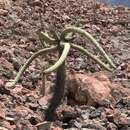pt-BR
nomes no trilho de navegação


Browningia candelaris ist eine Pflanzenart aus der Gattung Browningia in der Familie der Kakteengewächse (Cactaceae). Ein spanischer Trivialname ist „Chuyachaqui“.
Browningia candelaris wächst baumförmig und erreicht Wuchshöhen von bis zu 6 Metern. Der unverzweigte Stamm ist stark bedornt und erreicht Durchmesser von 50 Zentimetern. Die Krone besteht aus fast nicht bedornten, ausgebreiteten bis aufstrebenden, zylindrischen Trieben. Die rund 50 niedrigen Rippen sind gerundet. Die darauf befindlichen Areolen stehen eng beieinander. Die aus den Areolen entspringenden Dornen sind sehr dünn, gelblich braun bis bräunlich schwarz und bis 1,3 Zentimeter lang. Die blühfähigen Triebe sind unbedornt oder tragen einige wenige weißliche Borsten.
Die röhrenförmigen Blüten sind weiß und 8 bis 12 Zentimeter lang. Die essbaren Früchte sind gelb und bis 7 Zentimeter lang.
Browningia candelaris ist im Norden Chiles und im Süden Perus an den Hängen der Anden in Höhenlagen von etwa 1800 bis 2800 Metern verbreitet.
Die Erstbeschreibung als Cereus candelaris erfolgte 1833 durch Franz Julius Ferdinand Meyen.[1] Nathaniel Lord Britton und Joseph Nelson Rose stellten die Art 1920 in die Gattung Browningia.[2] Ein weiteres nomenklatorisches Synonym ist Cactus candelaris (Meyen) Meyen (1835).
Es werden folgende Unterarten unterschieden:[3]
In der Roten Liste gefährdeter Arten der IUCN wird die Art als „Data Deficient (DD)“, d. h. mit keinen ausreichenden Daten geführt.[4]
Die Früchte werden in Peru als Obst gegessen und zu Shampoo verarbeitet.
Browningia candelaris ist eine Pflanzenart aus der Gattung Browningia in der Familie der Kakteengewächse (Cactaceae). Ein spanischer Trivialname ist „Chuyachaqui“.
Browningia candelaris is a species of cactus from northern Chile and southern Peru. It has a distinctive growth habit, with a straight spiny trunk topped by more-or-less spineless thinner branches. In some places, the long-term survival of local populations may be threatened by grazing, which destroys seedlings.[2]
Browningia candelaris has a tree-like habit of growth, reaching a height of up to 6 m (20 ft). When mature, it has a distinct unbranched trunk with a diameter of up to 50 cm (20 in), which is densely covered with straight brown spines, 6–15 cm (2.4–5.9 in) long. Mauseth found spines of this species up to 10.2 inches (25.5 centimeters) in length.[3] Above the trunk the plant has a crown of branching thinner stems, which may be entirely spineless or bear spines reduced to a few bristles. All the stems have about 50 ribs.[2]
The white flowers are tubular, 8–12 cm (3.1–4.7 in) long and are followed by fleshy fruits, yellow when ripe and up to 7 cm (2.8 in) long. The fruits are edible.[2]
The species was first described as Cereus candelaris in 1833 by the German botanist Franz Julius Ferdinand Meyen.[4] In 1920, Britton and Rose placed it in the genus Browningia, named for Webster E Browning (1869-1942), director of the Instituto Inglés, Santiago, Chile.[2] Studies published from 2002 onwards using the methods of molecular phylogenetics suggest that the genus Browningia is polyphyletic (i.e. the genus is not a natural group descended from their most recent common ancestor). B. candelaris and B. hertlingiana are related to some species of Rebutia, whereas other species of Browningia are related to genera such as Pachycereus.[5]
Browningia candelaris has been found to contain psychotropic phenylethylamines N-acetyl-3,4-dimethoxyphenylethylamine, N,N-dimethyl-3,4-dimethoxyphenylethylamine, N,N-dimethyl-4-methoxyphenylethylamine and the substituted amphetamine 4-methoxyamphetamine.[6] The synthetic form of the last-named of these compounds has, since the 1970s, been manufactured as a designer drug of abuse and touted as MDMA - resulting in numerous hospitalisations and a number of fatalities.[7][8][9][10]
Based upon the discovery of the psychotropic effects of and subsequent use of such well-known hallucinogenic species as Lophophora williamsii and Echinopsis pachanoi by various groups of Native Americans, Echeverría & Niemeyer advance the very tentative hypothesis that B. candelaris might similarly have been investigated and employed by the original inhabitants of northern Chile:
The occasional use of B. candelaris as source of hallucinogens may be suggested, given its presence along the route connecting the settlements in the Azapa Valley of Northern Chile with the Titicaca basin in the Bolivian altiplano, the site of the Tiwanaku state.[6]
- citing in support of this conjecture a paper by Berenguer on the iconography employed in the art of Tiwanaku.[11]
Browningia candelaris is a species of cactus from northern Chile and southern Peru. It has a distinctive growth habit, with a straight spiny trunk topped by more-or-less spineless thinner branches. In some places, the long-term survival of local populations may be threatened by grazing, which destroys seedlings.
Browningia candelaris (Meyen) Britton & Rose, 1920, es una especie fanerógama perteneciente a la familia de las cactáceas.
Es un cactus de tamaño arborescente a arbóreo, hasta 5 m de altura; con ramificaciones situadas en su parte superior, dándole apariencia de un candelabro. Flores blancas, diurnas, con algo rosado, 1 dm de largo; fruto oval, de 7,5 cm de largo.
Endémico en el altiplano de Chile y Perú, entre 1700 a 3000 msnm, en condiciones de extrema sequedad. Tolera mínimas de 15 ºC.[1]
Browningia: nombre genérico otorgado en honor de Webster E. Browning (1869–1942), director del Instituto Inglés en Santiago de Chile.
candelaris: epíteto
Browningia candelaris (Meyen) Britton & Rose, 1920, es una especie fanerógama perteneciente a la familia de las cactáceas.
Browningia candelaris là một loài thực vật có hoa trong họ Cactaceae. Loài này được (Meyen) Britton & Rose mô tả khoa học đầu tiên năm 1920.[2]
Browningia candelaris là một loài thực vật có hoa trong họ Cactaceae. Loài này được (Meyen) Britton & Rose mô tả khoa học đầu tiên năm 1920.